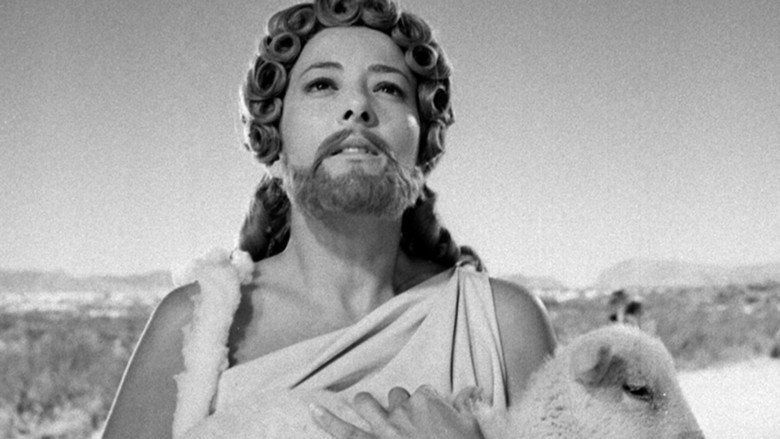Simon of the Desert
8.1 /10 2 Votes
Director Luis Bunuel Music director Raul Lavista | 8/10 IMDb 100% Rotten Tomatoes Genre Short, Comedy, Drama Duration | |||||||||||||||||||||||||||||||||
 | ||||||||||||||||||||||||||||||||||
Screenplay Luis Bunuel, Julio Alejandro Cast (The Devil), (Simón), Enrique Álvarez Félix (Brother Matías), Hortensia Santoveña (The Mother), Francisco Reiguera (The Devil as an Old Witch), Luis Aceves Castañeda (Priest)Similar movies Blackhat , Student Services , The Monk , Craving Desire , Paradise , Second Time Lucky | ||||||||||||||||||||||||||||||||||
Simon of the desert 1965 hd avi srpski titl deo 1 od 3
Simon of the Desert (Spanish: Simón del desierto) is a 1965 film directed by Luis Buñuel. It is loosely based on the story of the ascetic 5th-century Syrian saint Simeon Stylites, who lived for 39 years on top of a column.
Contents
- Simon of the desert 1965 hd avi srpski titl deo 1 od 3
- Synopsis
- Background
- Anecdotes
- Release
- Reception
- References

Simon of the Desert is the third (after Viridiana and The Exterminating Angel) of three movies that Buñuel had made starring Claudio Brook and Silvia Pinal and produced by her then-husband Gustavo Alatriste. Today it is generally acclaimed by film critics.

Synopsis

Simón, the son of Simeon Stylites, has lived for 6 years, 6 weeks and 6 days atop an eight-meter pillar in the middle of the desert, praying for spiritual purification. A congregation of priests and peasants salute him and offer him a brand new pillar to stand on and carry on his mission. He comes down from the pillar and is offered the priesthood, but refuses because he considers himself unworthy, and forsakes his aging mother for the love of God before climbing up his new pillar. He heals an amputee missing both hands, whose first use of them is to slap his child. But the congregation quickly departs unimpressed, leaving Simón alone.
Time goes by and Simón meets a number of regular characters – a handsome priest whom he condemns on grounds of vanity, a dwarf herder, and his mother, who comes to live close to him but remains neglected of his attention. A woman (Silvia Pinal), Satan, visits him three times: first as an innocent girl chanting curses in Latin, second disguised as Jesus. She constantly tries to make Simón give up his task and climb down from the pillar, but he refuses every time. She even possesses one of the priests that visit him, who is consequently exorcised by the other priests.
The third time, a coffin trails across the desert and finally stops next to the pillar. It opens up to reveal Satan, clad in a toga, who at last climbs up the pillar and vanishes with Simón for good. In an anachronistic turn, the couple find themselves sitting inside a crowded, jumping 1960s nightclub with a live instrumental rock band on stage. Satan tells Simón that the song the 1960s hipsters are dancing to (the dance is the twist) is called Radioactive Flesh. Simón protests about wanting to go home, but Satan says he cannot.
Background
In 1960 Buñuel returned to his home country Spain after a long-term exile in Mexico in order to direct Viridiana. The film scandalized the Vatican and the government, which prompted Buñuel into a second exile back to Mexico. There he directed The Exterminating Angel in 1962, and in the line of its predecessor, the film was critical of religion. Simón del desierto was the last of the trilogy starring Silvia Pinal and Claudio Brook (the latter usually in secondary roles) that controversially dealt with religion while retaining certain elements of Buñuel’s earlier surrealist period. The film was based on a novel of Buñuel, and was adapted by Buñuel and frequent collaborator Julio Alejandro.
Anecdotes
The Mexican actress Silvia Pinal revealed: "It is not true that Simon of the Desert was a medium-length film because of Gustavo Alatriste's economic troubles. It was a production problem. There were supposed to be three stories with different directors. Buñuel's was just one of them. Alatriste and I went to Europe to seek Federico Fellini, who was delighted to film with Buñuel, but he suggested his wife Giulietta Masina as the star. We saw another director, Jules Dassin, who would also accept if he was able to work with Melina Mercouri, his wife. We said no to them, because the idea was that the three stories would be starred by me. So, because everyone wanted to direct their own wives, Alatriste wanted to direct his own part with his wife, with me. I said no, and that was the beginning of our separation. Alatriste could not understand, or at least he was very hurt, when I explained to him that he could not direct besides Buñuel."
Release
Simon of the Desert was shown at the 1965 Venice Film Festival, where it won a Special Jury Prize. It was later shown in New York on February 11, 1969.
Reception
From a contemporary review, the Monthly Film Bulletin noted the short length of the film ensures "that Simon's isolation, shot by Figueora with marvellous ingenuity, never risks becoming tedious. On the other hand, Bunuel's creativity is in such fine form that one can't help regretting the loss of those unshot extra minutes." The review concluded that the film "makes for a startling, charming and healthily wicked little anecdote, with easily more sense to its hard theology than one could find in a whole tribe of biblical epics"
Simon of the Desert has received much acclaim since its original release; Rotten Tomatoes reports 100% approval among 15 critics, with an average rating of 8.5/10.
References
Simon of the Desert WikipediaSimon of the Desert Rotten TomatoesSimon of the Desert IMDb Simon of the Desert themoviedb.org
